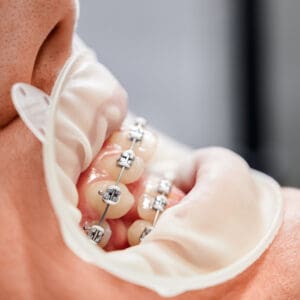![]()
Choosing between clear aligners and braces can be challenging, especially when it comes to treatment time.
Clear aligners are a popular option for those looking for a nearly invisible way to straighten their teeth. Typically, clear aligners can take anywhere from 6 to 18 months, depending on the complexity of the case.
On the other hand, traditional braces are often recommended for more severe dental issues. The treatment duration with braces usually ranges from 18 months to 3 years. Both options have their benefits, and the best choice depends on your specific dental needs.
To learn more and find the right solution for you, contact Smilebliss today!
Clear aligners are a modern orthodontic solution designed to adjust teeth alignment discreetly and comfortably. They are particularly suitable for addressing mild-to-moderate issues.
 Clear aligners consist of a series of custom-made plastic trays that fit snugly over the teeth. These trays are designed based on digital impressions or scans, which capture the specific details of the patient’s dental structure. Each set of aligners is worn for about two weeks before switching to the next set, gradually shifting the teeth into the desired position.
Clear aligners consist of a series of custom-made plastic trays that fit snugly over the teeth. These trays are designed based on digital impressions or scans, which capture the specific details of the patient’s dental structure. Each set of aligners is worn for about two weeks before switching to the next set, gradually shifting the teeth into the desired position.
The aligners must be worn for 20-22 hours a day for optimal effectiveness. Patients can remove them for eating, drinking, brushing, and flossing. This flexibility makes clear aligners a convenient option for many individuals.
One major advantage of clear aligners is their unobtrusive appearance. Made from transparent plastic, they are almost invisible when worn, which is appealing to those who prefer a subtle orthodontic treatment.
Clear aligners are also removable, allowing for easier maintenance of oral hygiene compared to traditional braces. This removability means no dietary restrictions, as patients can take the aligners out when eating their favorite foods.
Comfort is another benefit. Clear aligners typically cause less irritation to the cheeks and gums because they lack the metal brackets and wires found in braces. This leads to a more pleasant treatment experience.
Traditional braces have been a staple in orthodontic treatment, providing robust solutions for various dental issues. They are particularly effective for correcting complex bite misalignments and significant tooth movements.
 Traditional braces consist of metal brackets bonded to the teeth and connected by archwires. These brackets and wires apply continuous pressure, gradually moving the teeth into their desired positions.
Traditional braces consist of metal brackets bonded to the teeth and connected by archwires. These brackets and wires apply continuous pressure, gradually moving the teeth into their desired positions.
Adjustments are made periodically to change the pressure exerted by the wires, aligning the teeth over time. Elastic bands may be used to enhance tooth movement. The average treatment time can range from 18 months to 3 years, depending on the severity of dental problems.
Traditional braces are a tried-and-true method for achieving significant orthodontic results, although they come with aesthetic and lifestyle considerations.
When choosing orthodontic treatment, the duration can be a significant consideration. Clear aligners and braces each offer unique timelines affected by the complexity of the case and the patient’s commitment to wearing the devices.
Clear aligners are often chosen for their aesthetic appeal and relatively quicker treatment times for mild to moderate cases. These aligners typically require 6 to 18 months to achieve the desired results. Patients with minor dental adjustments might complete their treatment within as little as 6 months.
Complex cases requiring extensive movement can extend the duration to 24 months. Clear aligners must be worn for at least 20-22 hours per day to be effective. Alignment progress is monitored through regular visits to the orthodontist, typically every 6 to 8 weeks, where new aligners are provided to ensure continuous adjustment.
Compliance is critical; failure to consistently wear aligners can lead to longer treatment times. Given their removability, clear aligners might require more discipline from the patient compared to traditional braces.
Traditional braces are highly effective for a wide range of dental issues, including complex cases involving severe bite problems or significant tooth misalignment. The average treatment duration for braces ranges from 18 to 36 months. Some patients with minor corrections may complete their treatment in about a year.
The hardware, consisting of brackets, wires, and sometimes rubber bands, allows for constant pressure, aiding more extensive adjustments. Monthly appointments with the orthodontist are common to make necessary adjustments and monitor progress.
Braces assure consistent application of pressure since they are fixed to the teeth. This often results in a more predictable outcome within a specific timeframe. Patients, though, should be prepared for longer treatment durations compared to clear aligners, especially for more severe dental corrections.
Treatment duration for clear aligners and braces varies significantly based on several critical factors. These include the complexity of dental issues, patient compliance with the treatment regimen, and the individual’s age and biological response to orthodontic corrections.
The severity of dental misalignment is a primary factor in determining how long treatment with clear aligners or braces will take. Cases involving severe overcrowding, bite issues, or significant gaps generally require more extended treatment periods.
Mild misalignments may be corrected in as little as six months. For moderate issues, treatment can take between 12 and 18 months. In contrast, severe cases often necessitate a duration of 18 to 24 months or longer. Clear aligners are typically suited for mild to moderate issues, while braces can handle more complex cases.
Patient compliance significantly impacts the effectiveness and duration of orthodontic treatment. For clear aligners, individuals must wear the trays for at least 20 to 22 hours per day. Failure to adhere to this can result in prolonged treatment times and less effective results.
With braces, compliance involves attending regular orthodontic appointments and following care guidelines. Skipping appointments or neglecting oral hygiene can lead to setbacks.
Whether using aligners or braces, strict adherence to professional advice is crucial for achieving timely and successful results.
Age and biological factors also play roles in treatment duration. Younger patients, especially teenagers, often experience quicker adjustments due to ongoing growth and development, which can make teeth move more rapidly.
Adults may experience slower adjustments since their bones are denser and more fully developed. Biological factors such as bone density and the health of periodontal tissues affect how quickly teeth can move into new positions. While clear aligners are effective for both adults and younger patients, the biological nuances must be considered in forming realistic treatment timelines.
At Smilebliss, we offer both clear aligners and braces to help you achieve the smile you desire. Our team is here to guide you through every step of your orthodontic journey, ensuring you receive the best care tailored to your needs.
Keep in touch with Smilebliss today to schedule your consultation and start your path to a perfect smile.
For most patients, clear aligner treatment generally lasts between 6 and 18 months. Traditional braces might take slightly longer, typically requiring 1 to 3 years. The specific duration depends on individual orthodontic needs and the complexity of the case.
Several factors can affect treatment duration, including the severity of the misalignment, patient compliance with wearing aligners, and the specific orthodontic issues being addressed. Maintaining consistent wear time (usually 20-22 hours per day) is crucial for Invisalign’s effectiveness.
Clear aligners are less noticeable and generally more comfortable, which might encourage better compliance and result in quicker treatment. Braces can be more effective for severe alignment and bite issues. The need for regular dental visits for adjustments can also extend the treatment time for braces.
Yes, the complexity of a patient’s orthodontic issues plays a significant role in determining the most efficient treatment method. Severe cases of misalignment or bite problems are often better addressed with traditional braces, which may offer more robust correction in complex scenarios.